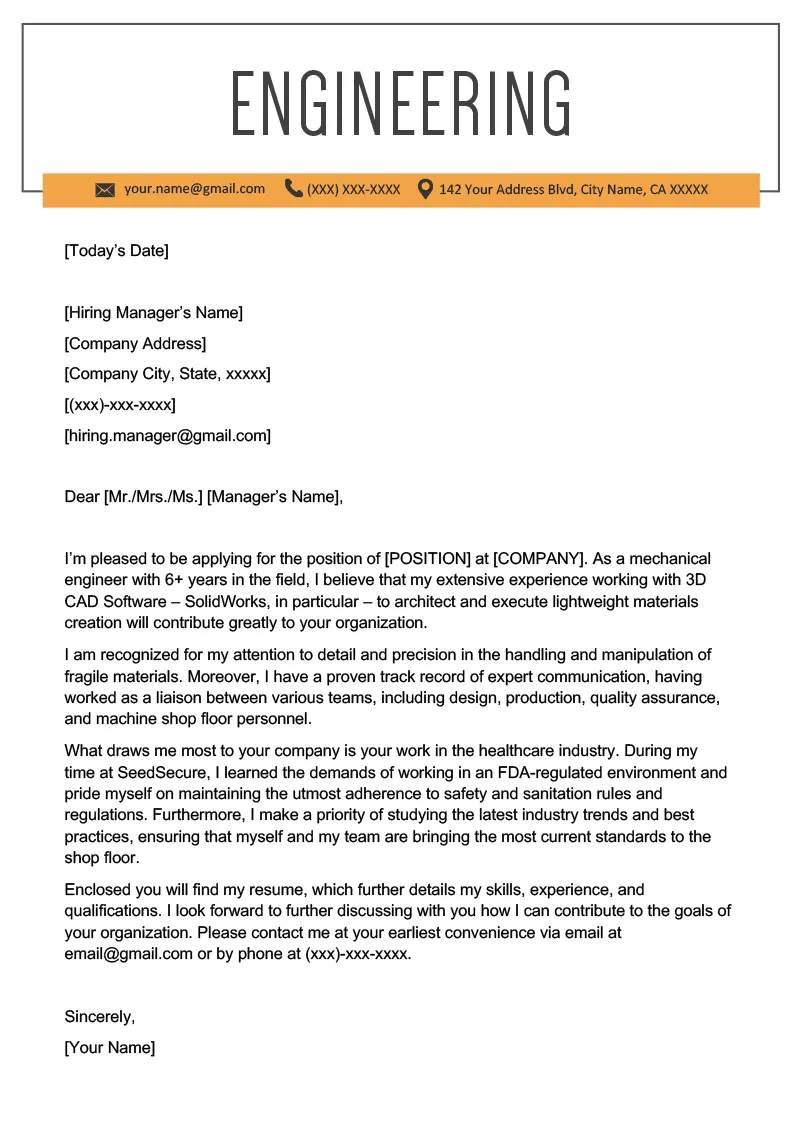Why a Cover Letter Matters for Electrical Engineers
In the competitive field of electrical engineering, a well-crafted cover letter is your first opportunity to make a strong impression on potential employers. It serves as more than just a formality; it’s a crucial tool that can significantly increase your chances of landing an interview. Your resume provides a snapshot of your qualifications, but the cover letter allows you to tell your story, demonstrate your personality, and highlight the specific reasons why you’re the ideal candidate for the job. It allows you to connect your skills and experiences directly to the requirements of the position and showcase your genuine interest in the company and the role. A compelling cover letter can differentiate you from other applicants, especially when many candidates might possess similar technical skills and experiences. It’s your chance to add a personal touch and make a lasting impact on the hiring manager.
Key Components of an Electrical Engineer Cover Letter
A successful cover letter for an electrical engineer combines technical expertise with strong communication skills. The key components ensure you present yourself professionally and persuasively. Each section should be carefully constructed to make the most of your application, helping the reader to quickly recognize your suitability for the role. It’s important to remember that the cover letter is your chance to make a great first impression. Properly structured cover letters highlight your accomplishments, passions, and your suitability for the role. By following a clear framework, you can craft a document that boosts your chances of getting noticed and helps you stand out from the competition. Let’s explore the essential elements that make up a compelling cover letter.
Your Contact Information and the Recruiter’s
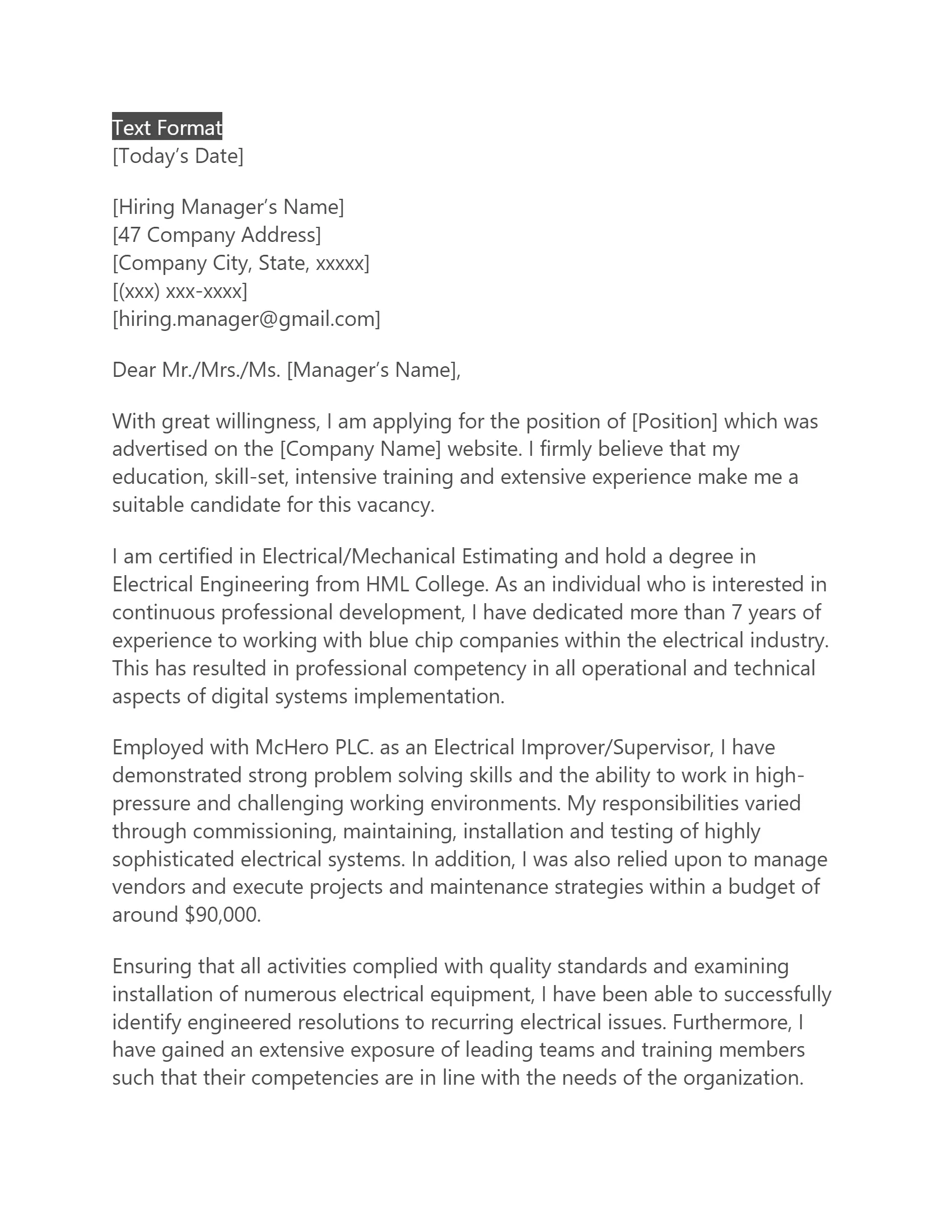
Start your cover letter by clearly providing your contact information. Include your full name, phone number, professional email address, and optionally, your LinkedIn profile URL or a link to your online portfolio if you have one. This is typically placed at the top of the letter. Directly below your information, include the date and the recipient’s contact details. If you know the hiring manager’s name and title, use it; otherwise, use the department or company address. Ensuring this information is accurate and easy to find allows the recruiter to quickly contact you if they decide to move forward with your application. The correct formatting here demonstrates attention to detail and professionalism.
Professional Greeting and Introduction
Address your cover letter to the specific hiring manager or the relevant department. Using ‘Dear Mr./Ms. [Last Name]’ is the most professional approach. If the name is unavailable, you can use a general greeting like ‘Dear Hiring Manager’. The introduction should be concise and grab the reader’s attention. State the position you’re applying for, how you found the job posting (e.g., company website, job board), and briefly mention your most relevant qualifications or skills. The introduction should create a positive first impression and entice the recruiter to read further. Making a strong opening statement sets the tone for the rest of the letter and gives you the opportunity to make a good impression from the start.
Highlighting Your Skills and Expertise
This is where you showcase your core skills and expertise. Tailor this section to match the job description. Identify the key skills and qualifications the employer is seeking. Then, explain how your skills and expertise align with these requirements. Use action verbs to describe your achievements. Be specific about your abilities, such as your experience with circuit design, power systems, embedded systems, or any other relevant areas. Mention any specialized software, tools, or equipment you’re proficient in. Providing concrete examples helps demonstrate to the recruiter that your skills are relevant and applicable to the open role. Ensure the skills you list directly correspond to the job requirements; this improves your chances of making a good impression and passing initial screenings.
Quantifiable Achievements and Project Examples
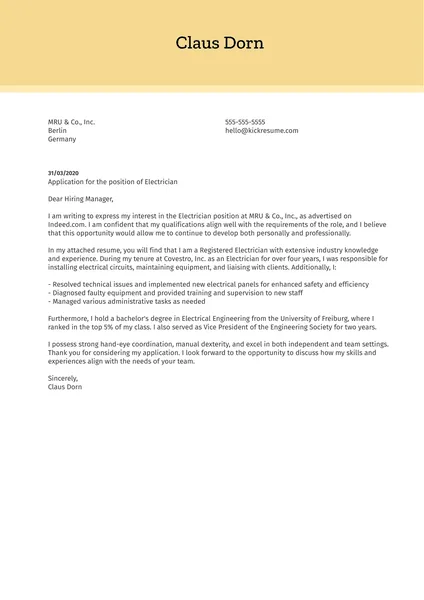
Go beyond simply listing your skills; provide concrete examples of your accomplishments. Quantify your achievements whenever possible. For instance, instead of saying ‘Improved system efficiency,’ you could say ‘Improved system efficiency by 15% through optimized circuit design.’ Describe projects where you successfully applied your engineering skills. Explain the problem you solved, the actions you took, and the results you achieved. Use the STAR method (Situation, Task, Action, Result) to structure your project descriptions. This method helps create a clear narrative of your past successes. Highlighting quantifiable achievements gives recruiters concrete evidence of your capabilities and the value you can bring to their organization. Provide specific and measurable results for a clear view of your successes.
Demonstrating Passion and Company Alignment
Express your genuine interest in the company and the specific role. Do some research to understand the company’s mission, values, and recent projects. Explain why you’re excited about this opportunity. Relate your skills and experiences to the company’s goals. Describe how you see yourself contributing to their success. Demonstrate your understanding of the industry and the company’s place within it. Briefly mention any specific projects, products, or technologies that appeal to you. Showing that you’ve invested time in understanding their organization conveys a strong level of interest and increases your chances of making a favorable impression. Expressing a strong understanding and alignment with their values will make your application more attractive.
Call to Action and Professional Closing
Conclude your cover letter with a clear call to action. Express your enthusiasm for the opportunity and state your interest in an interview. Thank the hiring manager for their time and consideration. Reiterate your contact information. Use a professional closing, such as ‘Sincerely,’ ‘Best regards,’ or ‘Yours sincerely,’ followed by your name. This section is your final chance to reiterate your interest and make a good impression. Making a clear call to action ensures that the reader knows you are ready for the next step in the hiring process. A well-crafted closing reinforces your professionalism and leaves a positive lasting impression on the reader.
Formatting and Design Best Practices
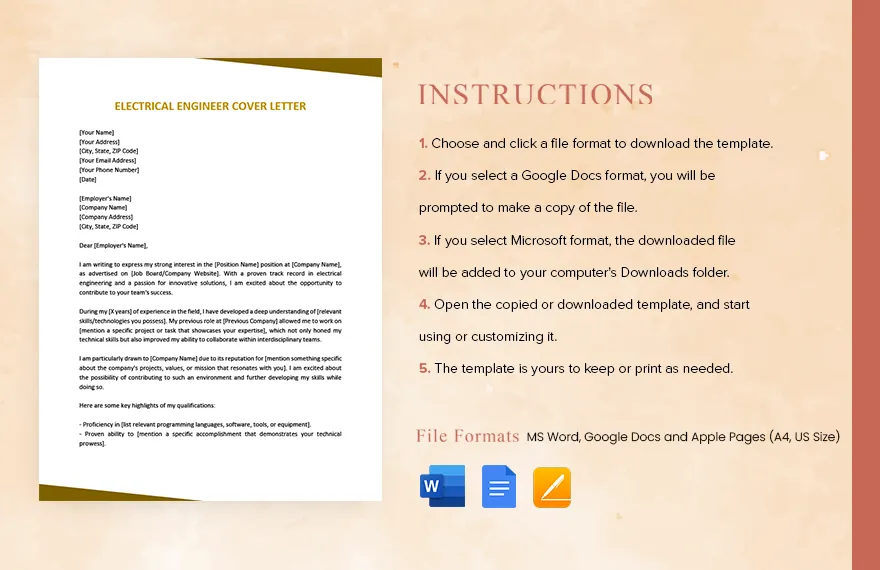
The formatting and design of your cover letter are just as important as its content. A well-formatted letter is easy to read and creates a positive impression. Proper formatting makes it easier for the reader to follow your arguments and get a clear idea of your qualifications. A clean and well-organized cover letter reflects your professionalism and attention to detail. Ensure a professional look and feel throughout your application.
Font and Readability
Choose a professional and readable font. Recommended fonts include Arial, Calibri, Times New Roman, or Helvetica. Keep the font size between 10 and 12 points for comfortable reading. Use a consistent font throughout your cover letter. Avoid using unusual or decorative fonts, as they can be distracting. The goal is to make your letter easy to read and visually appealing. Maintaining good readability ensures the reader can focus on the content of your letter. A simple font style enhances readability and reinforces your message.
Length and Structure
Keep your cover letter concise, ideally one page long. Recruiters are busy, so get to the point quickly. Use a clear and logical structure with distinct sections. Use headings and subheadings to organize your content and improve readability. Ensure the letter is well-spaced with clear paragraphs, avoiding dense blocks of text. Well-structured formatting makes it easy for the recruiter to quickly find the information they need. Concise and well-structured letters show that you respect the reader’s time and can clearly convey your thoughts.
Proofreading and Editing

Proofread your cover letter carefully for any typos, grammatical errors, and punctuation mistakes. These errors can detract from your professionalism. Ask a friend or colleague to review your letter for a fresh perspective. Read the letter aloud to catch any awkward phrasing or sentences that may not flow smoothly. Ensure your formatting is consistent throughout the document. A polished cover letter shows attention to detail and professionalism. Thorough proofreading demonstrates that you are committed to producing high-quality work. Correcting any errors guarantees that you make a good impression.
Tailoring Your Cover Letter to the Job Description
One of the most important elements is tailoring your cover letter to the job description. Customizing your cover letter to the specific job you’re applying for shows that you are genuinely interested in the role and have taken the time to understand the company’s needs. It allows you to directly address the requirements and highlight the skills that are most relevant to the position. This approach significantly increases your chances of getting noticed and advancing in the application process. Adapting your cover letter boosts its effectiveness and increases your chances of moving forward in the selection process.
Researching the Company and the Role
Before writing your cover letter, research the company and the specific role. Visit the company’s website, read about their mission, values, and recent projects. Look at their LinkedIn page and any recent news or announcements. Understand the role’s responsibilities and required skills. Identify the key requirements and expectations mentioned in the job description. Demonstrating your knowledge of the company and the role shows that you are a proactive candidate. Researching the company and role provides the groundwork needed to create a relevant and impactful cover letter. Your ability to understand the role is a crucial factor.
Matching Skills and Requirements
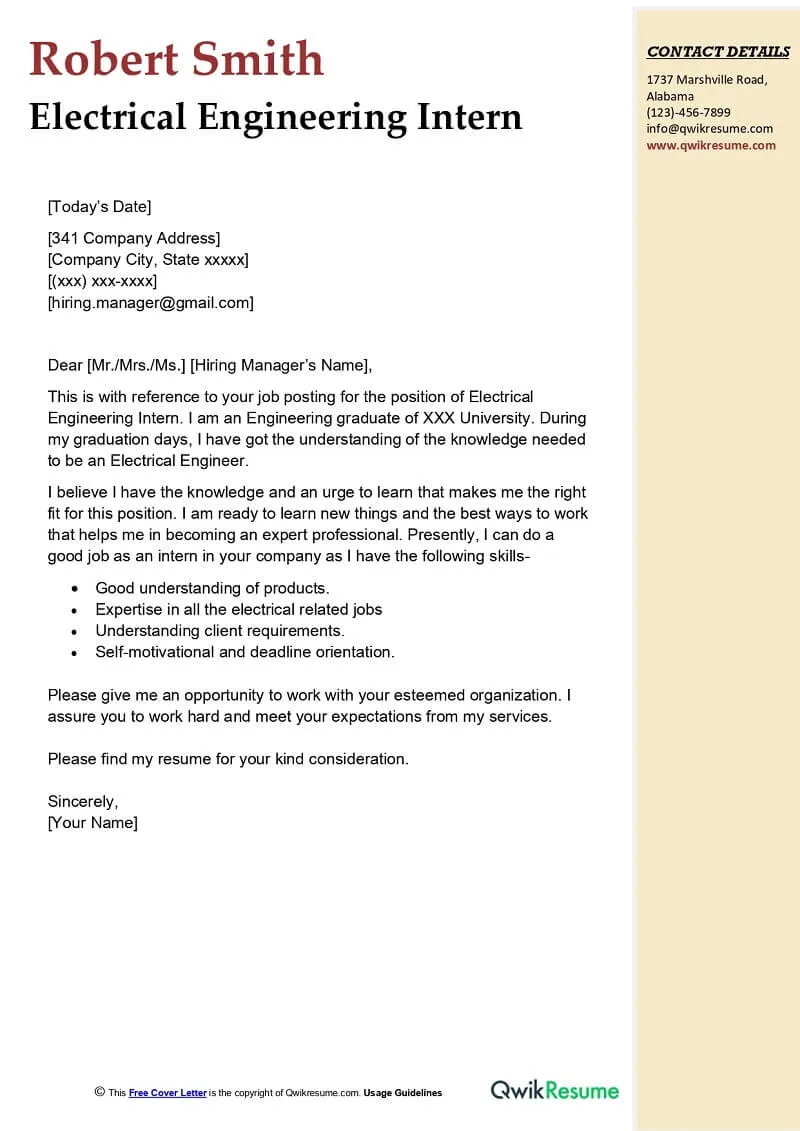
Carefully analyze the job description and identify the key skills, qualifications, and experiences the employer is seeking. Align your skills and experiences with the requirements. Provide specific examples of how you have demonstrated these skills in the past. Use the same keywords and phrases that are used in the job description to describe your skills and experiences. This helps the recruiter quickly identify that you meet the required criteria. Use the job description as a roadmap for your cover letter. Making a direct connection between your skills and the job requirements strengthens your application.
Keywords Optimization
Incorporate relevant keywords from the job description throughout your cover letter. Applicant Tracking Systems (ATS) often scan for specific keywords to identify qualified candidates. Use keywords in your introduction, skill descriptions, and project examples. However, avoid keyword stuffing. Use keywords naturally and in context. Your goal is to clearly demonstrate that you possess the required skills and experiences. Focusing on relevant keywords improves your chances of getting noticed by both human recruiters and ATS systems. Incorporating keywords is an effective strategy.
Electrical Engineer Cover Letter Samples and Examples
Reviewing cover letter samples can provide valuable insights and help you get started. Cover letter samples offer a clear guide on format, content, and tone. They help you to effectively present your qualifications. Samples demonstrate how to align skills with job requirements and showcase your expertise. They also help in understanding the overall format and structure of an application. Properly used samples and examples are very helpful when crafting your own effective cover letter.
Sample 1
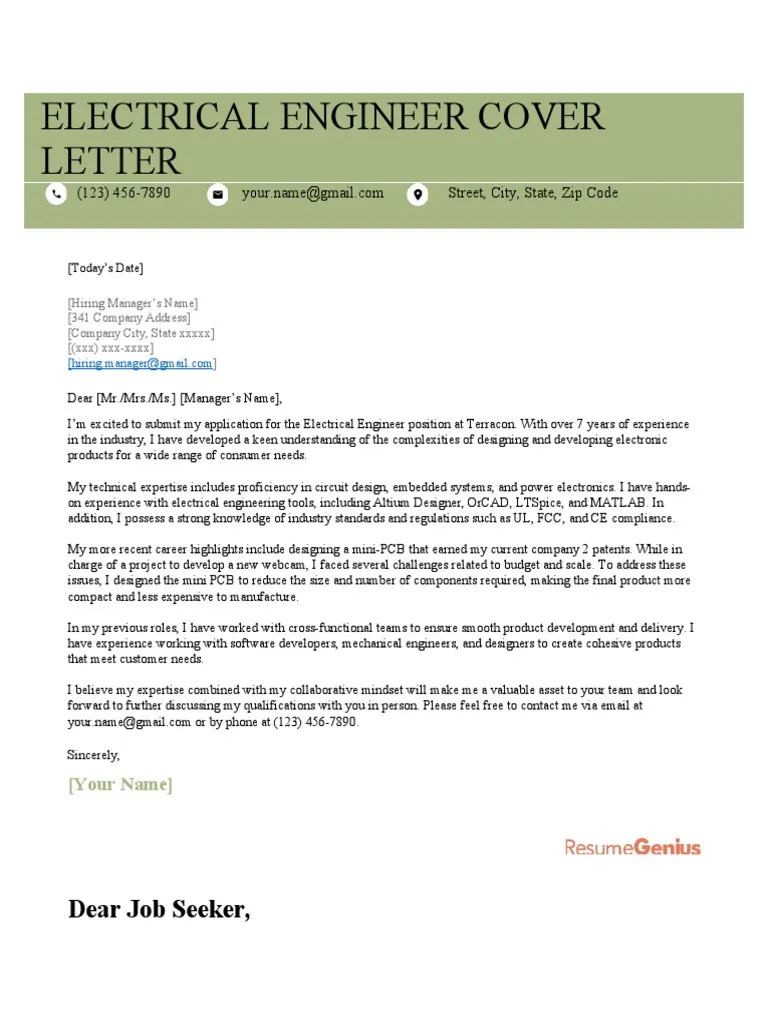
Dear [Hiring Manager name],
I am writing to express my interest in the Electrical Engineer position at [Company name], as advertised on [Platform]. With [Number] years of experience in electrical engineering, I am confident that my skills and experience align perfectly with the requirements of this role. In my previous role at [Previous Company], I was responsible for [list of responsibilities]. I successfully [achievements]. I am proficient in [list of software and technologies]. I am eager to bring my expertise to [Company name] and contribute to your team’s success. Thank you for your time and consideration. I look forward to the opportunity to discuss my qualifications further.
Sincerely, [Your Name]
Sample 2
Dear [Hiring Manager name],
I am excited to apply for the Electrical Engineer position at [Company name], as seen on [Platform]. I have a strong background in electrical design, with proven expertise in power systems, circuit analysis, and embedded systems. In my role at [Previous Company], I led a project where I [Specific achievement, e.g., reduced energy consumption by 15%]. I am proficient in [list of software and technologies]. I am particularly drawn to [Company name]’s work in [Specific area]. I am available for an interview at your earliest convenience.
Sincerely, [Your Name]
Common Mistakes to Avoid in Your Cover Letter
Avoiding common mistakes in your cover letter will significantly improve your chances of success. Common mistakes can immediately disqualify your application. Taking care and awareness of these issues can ensure that your letter makes a positive impression. These issues can easily be avoided with attention to detail.
Generic Language
Avoid using generic language and clichés. Instead of saying ‘I am a team player,’ provide specific examples of how you have worked effectively in teams. Customize your cover letter for each job. Avoid using the same letter for every application. Generic language fails to highlight your unique qualifications and shows a lack of genuine interest in the position. Tailor the language to be relevant to the specific company and the role. Showcasing your personalized approach gives you a competitive edge.
Typos and Grammatical Errors
Typos and grammatical errors can damage your credibility and make you appear unprofessional. Always proofread your cover letter carefully before submitting it. Use a spell checker and grammar checker. Ask a friend or colleague to review your letter. These errors can create a negative first impression, indicating a lack of attention to detail. Always ensure that your cover letter is free of mistakes. Proofreading helps guarantee that you show that you are dedicated to delivering high-quality work.
Focusing on Yourself Too Much
While you need to highlight your skills and experiences, avoid making the letter all about you. Focus on how your skills and experiences can benefit the company. Relate your qualifications to the company’s needs and goals. Emphasize what you can bring to the role and how you can contribute to the company’s success. This approach shows the hiring manager that you are focused on the company’s needs. Focusing too much on your own accomplishments can make the reader believe you are not interested in the company’s goals. Keeping the company’s perspective in focus is crucial.
Conclusion
Writing an effective cover letter is a critical part of the job application process for electrical engineers. A well-crafted cover letter can distinguish you from other candidates and increase your chances of landing an interview. By following these guidelines and tips, you can create a compelling cover letter that highlights your skills, experiences, and enthusiasm for the role. Tailoring your cover letter to each job application is key. Remember to research the company, match your skills to the requirements, and showcase your achievements with quantifiable results. Avoid common mistakes like generic language and grammatical errors. With a well-written cover letter, you’ll be well on your way to a successful career in electrical engineering. Make every cover letter your best effort.
